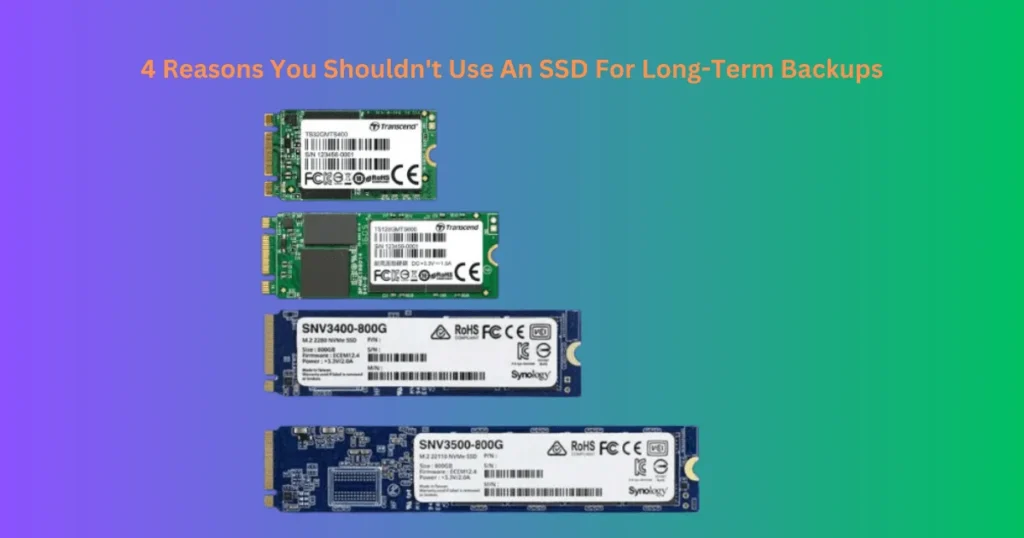4 Reasons You Shouldn't Use an SSD for Long-Term Backups

Introduction,
4 Reasons you shouldn’t use an SSD for long-term backups. Solid-state drives are now the go-to solution for high-performance storage in the rapidly evolving digital world of today. They are better than traditional Hard Disk Drives in multiple facets, comprising silence operation, lightning-fast startup times, and shorter file access delays. SSDs might not be the best option for but long-term data storage.
Table of Contents
ToggleThis article examines better options and evaluates the four main reasons SSDs aren’t suitable for long-term storage. Recognizing these restrictions can help you prevent potential data loss, resource waste, and the irritation, anyhow of your level of experience.
Key Takeaways
- SSDs are not designed for long-term, idle data storage.
- The high cost of SSDs makes them impractical for backups.
- Write endurance and sudden failure risks further reduce their reliability for archival purposes.
- For long-term backups, cloud storage, tape drives, and HDDs are superior options.
1. Limited Data Retention Over Time
SSDs, in contrast to traditional hard drives, are susceptible to data decline after extended lack of activity. The technology underlying SSD storage, which depends on flash memory cells, is the main cause of this problem.
How SSDs Store Data
NAND flash memory, which is used in SSDs, uses specialized cells to electrically store data. By storing electric charges that correspond to binary values 1s and 0s these cells are able to maintain information. However, over time, the electric charges tend to leak, causing data corruption or complete data loss if the drive remains unused.
Why This Is Problematic for Long-Term Backups
For long-term backup solutions, you often store data and leave it untouched for months or even years. Unlike HDDs, which rely on magnetic storage (a more durable form for idle storage), SSDs need periodic power-ups to refresh the stored data. If you store critical backups on an SSD and leave it sitting for years, you may find that the data has faded or become inaccessible.
Key Point: SSDs need regular use and power to maintain data integrity.
2. High Cost Per GB Compared to HDDs
Cost-effectiveness is a critical factor when it comes to backups. High-capacity devices are necessary for long-term storage since managing large volumes of data is frequently required.
The Price what’s different between HDDs and SSDs
Despite substantial price reductions over time, SSDs are still far more expensive per gigabyte than conventional hard drives. For instance:
- Usually, a 1TB SSD costs between $70 and $100.
- A 1TB HDD, meanwhile, may be purchased for as low as $30 to $50.
The expenses quickly mount up when backing up several terabytes of data. For most users, purchasing SSDs for backups is neither cost-effective nor feasible, particularly when HDDs provide a less expensive option that is reliable enough for archival uses.
Long-Term Backups Don’t Need Speed
Although SSDs are valued for their speed and performance, long-term backups do not benefit from those features. Since backups are typically not accessible, an SSD’s speed benefits are squandered. With HDDs, you can achieve the same storage goals at a much lower cost.
Key Point: SSDs are unnecessarily expensive for data that will rarely be accessed.
3. Write Endurance Limitations
Every storage device has a restricted lifespan, but the write perseverance of SSDs is especially limited. An SSD’s flash memory cells can only resist a specific number of write cycles before failing and losing all value.
Understanding Write Cycles
Program/Erase (P/E) cycles are used by SSDs to write and delete data. The NAND flash memory cells deteriorate a little with each P/E cycle. This eventually results in decreased performance and data failure. Even while wear leveling and other current SSD technologies have increased their endurance, they are still unsuitable for long-term write-heavy workloads like periodic backups.
Why It Matters for Backups
When you perform regular backups to an SSD (incremental or full), the write operations can accelerate the wear and tear of the drive. If the SSD reaches its write endurance limit, it will fail, leaving your critical backup data at risk.
In contrast, HDDs have no such strict write cycle limits. While HDDs can fail due to mechanical issues, their ability to handle frequent backups over the years makes them a more robust solution for long-term storage.
Key Point: SSDs are less durable for frequent backup operations compared to HDDs.
4. Risk of Sudden and Catastrophic Failure
Another critical drawback of SSDs for long-term backups is the risk of sudden and complete failure. Unlike HDDs, which often show signs of mechanical wear (strange noises, slower speeds), SSD failures tend to happen without warning.
Why SSD Failures Are Sudden
Because SSDs don’t have any moving parts, they are frequently commended for their dependability. But this same characteristic also results in a unique failure mode:
- SSDs rely on controllers and NAND flash memory.
- If the drive’s controller fails or NAND flash cells become corrupted, the SSD can fail abruptly.
- In many cases, data recovery from a failed SSD is far more complex and costly compared to HDD recovery.
Implications for Long-Term Backups
For long-term backup purposes, you need a storage medium that offers predictable behavior and recovery options. HDDs typically degrade gradually, giving you a chance to recover your data before complete failure on the other hand, irrevocable data loss may result from an SSD’s sudden and catastrophic failure.
Key Point: SSDs are a dangerous option for long-term backups since they are more prone to unexpected and abrupt failures.
Alternatives to SSDs for Long-Term Backups
After discussing the reasons SSDs aren’t the greatest choice for long-term storage, let’s examine three more dependable options:
- HDDs (hard disk drives)
- For long-term backups, HDDs remain the most reliable and reasonably priced solution.
- Large storage capacity is offered by them at incredibly low prices per GB.
- They can continue to function for many years with the right upkeep, such periodic power-ups.
- Tape Storage
- For many years, tape drives have been a dependable option for archival storage.
They offer incredible durability, frequently lasting more than 20 years, are incredibly durable, and are reasonably priced for storing massive volumes of data.
- Best suited for enterprises or users with large-scale backup needs.
- Cloud Storage
- Cloud-based backup solutions, such as Google Drive, AWS Glacier, or Dropbox, provide redundancy and accessibility.
- Data is stored on servers with robust protections against failure.
- However, ongoing subscription costs and internet dependency may not suit everyone.
In conclusion,
4 Reasons you shouldn’t Use an SSD for long-term backups. Although SSDs are really fast, energy effectiveness, and performance, they are not enough. when it comes to extended data backups. Issues like issues with data retention, expensive, write endurance limits, and disastrous failure risks make SSDs a bad decision for keeping important, archival data over long stretches of time. For long-term storage, options like HDDs, tape drives, and cloud storage offer increased dependability, cost- efficacy, and tranquility of mind. By comprehension the limitations of SSDs, you can make smarter decisions to Keep your valuables safe data for years to come.
FAQs
Periodically restarting the SSD and checking the data is one option, but it necessitates ongoing maintenance and doesn’t completely remove all dangers.
The slow loss or deterioration of data contained in a digital medium is referred to as bit rot. SSDs are especially susceptible to damage when they are not powered on for extended periods.
Even though enterprise SSDs might have superior controllers and more longevity, they nevertheless have the same hazards when utilized for extended periods without power.
An SSD’s data retention period, which often ranges from one to five years, varies based on the drive’s quality and storage circumstances.
For longer-term data archiving, more dependable choices include HDDs, cassette drives, and cloud storage.
For quick, daily use in active systems, SSDs are great. However, the constraints for long-term offline storage are frequently overlooked in their promotion.


